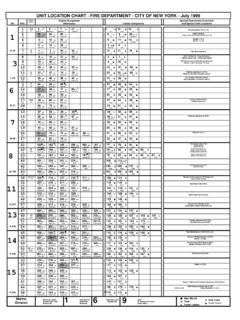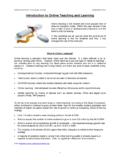Transcription of Suggested citation: Centers for Disease Control and ...
1 Suggested citation: Centers for Disease Control and prevention and American water Works Association. emergency water supply planning guide for hospitals and health care facilities. Atlanta: Department of Health and Human Services; 2012. The findings and conclusions in this report are those of the author(s) and do not necessarily represent the views of their agencies or organizations. The use of trade names is for identification only and does not imply endorsement by authoring agencies or organizations. emergency water supply planning guide for Hospitals and Health Care Facilities; ii emergency water supply planning guide for Hospitals and Health Care Facilities American water Works Association and Centers for Disease Control and prevention emergency water supply planning guide for Hospitals and Health Care Facilities; iii Acknowledgments The funding of this handbook was a collaboration between the American water Works Association s (AWWA s) water Industry Technical Action Fund and the Centers for Disease Control and prevention s (CDC s) National center for Emerging and Zoonotic Infectious Diseases and National center for Environmental Health.
2 The following Core Strategy Team assisted in the development of this handbook: Matt Arduino (CDC) John Collins (American Society for Healthcare Engineering) Charlene Denys ( Environmental Protection Agency Region 5) David Hiltebrand (AH Environmental Consultants, Inc.) Mark Miller (CDC) Drew Orsinger ( Department of Homeland Security) Alan Roberson (AWWA) John C. Watson (CDC) A workshop was held in Atlanta on November 3-4, 2009, to review the draft handbook. The following attendees provided additional assistance to the Core Strategy Team in the development of this handbook: Steve Bieber (Metropolitan Washington Council of Governments) Michael Chisholm (Joint Commission) David Esterquest (Central DuPage Hospital) Karl Feaster (Children s Healthcare of Atlanta) Mary Fenderson (Kidney emergency Response Coalition) Dale Froneberger (EPA Region 4) Shelli Grapp (Iowa Department of Natural Resources) Don Needham (Anne Arundel County, Maryland) Patricia Needham (Children s National Medical center ) Tom Plouff (EPA Region 4) Brian Smith (EPA Region 4) John Wilgis (Florida Hospital Association) Charles Williams (Georgia Department of Natural Resources) Janice Zalen (American Health Care Association) The Core Strategy Team would also like to thank Zeina Hinedi, (AH Environmental Consultants, Inc.)
3 For her contribution to Section 7, emergency water Alternatives, and to Kim Mason (AH Environmental Consultants, Inc.) for her diligent and patient editing and preparation of this document. emergency water supply planning guide for Hospitals and Health Care Facilities; iv Contents 1. ABBREVIATIONS AND ACRONYMS .. 1 2. EXECUTIVE SUMMARY .. 3 3. INTRODUCTION .. 5 4. OVERVIEW OF PLAN DEVELOPMENT 8 5. PLAN ELEMENTS .. 10 6. water USE AUDIT .. 12 water USE AUDIT WORK PLAN .. 12 APPROACH .. 12 STEP 1: DETERMINE water USAGE UNDER NORMAL OPERATING CONDITIONS .. 13 STEP 2: IDENTIFY ESSENTIAL FUNCTIONS AND MINIMUM water NEEDS .. 14 STEP 3: IDENTIFY emergency water CONSERVATION MEASURES .. 16 STEP 4: IDENTIFY emergency water supply OPTIONS .. 17 STEP 5: DEVELOP emergency water RESTRICTION PLAN.
4 18 7. emergency water ALTERNATIVES .. 20 OVERVIEW AND INITIAL DECISION MAKING .. 20 STORAGE TANKS .. 24 OTHER NEARBY water SOURCES .. 28 TANKER-TRANSPORTED water .. 35 LARGE TEMPORARY STORAGE TANKS (GREATER THAN 55 GALLONS) .. 39 water STORAGE CONTAINERS (55 GALLONS AND SMALLER) .. 44 water STORAGE LOCATION AND ROTATION .. 47 PORTABLE TREATMENT UNITS .. 47 CONTAMINANTS: BIOLOGICAL AND CHEMICAL .. 48 TREATMENT TECHNOLOGIES .. 48 emergency water supply planning guide for Hospitals and Health Care Facilities; v 8. 58 9. REFERENCES .. 59 10. BIBLIOGRAPHY .. 62 APPENDIX A: CASE STUDIES .. 65 CASE STUDY NO. 1: LARGE ACADEMIC MEDICAL FACILITY .. 65 CASE STUDY NO. 2: NURSING HOME .. 68 APPENDIX B: EXAMPLE PLAN .. 69 INTRODUCTION .. 69 PROJECT APPROACH.
5 69 water USE AUDIT RESULTS .. 70 OPERATING DURATION OF RESERVOIR DURING water OUTAGE .. 71 RECOMMENDED RESPONSE PLAN FOR water OUTAGE .. 71 ADVANCED emergency PREPARATIONS .. 71 NONESSENTIAL SERVICES .. 72 OTHER water CONSERVATION MEASURES .. 72 ISOLATION OF water supply .. 72 emergency SUPPORT SERVICES .. 74 APPENDIX C: LOSS-OF- water -SCENARIO .. 75 DOES YOUR emergency MANAGEMENT PLAN ADDRESS THE FOLLOWING ISSUES? .. 75 APPENDIX D: EXAMPLE water USE AUDIT FORMS 1 AND 2 .. 84 DEPARTMENT water USE AUDIT FORM 1 POPULATION .. 84 DEPARTMENT water USE AUDIT FORM 2 - ACTIVITY water USE .. 85 APPENDIX E: PORTABLE water FLOW METERS .. 86 emergency water supply planning guide for Hospitals and Health Care Facilities; vi List of Tables Table Some Typical water Usage Functions/Services.
6 14 Table List of Essential Functions .. 16 Table Example of emergency water Storage and Usage Estimates .. 26 Table Bladder and Pillow Tank Sizes .. 39 Table Onion Tank Sizes .. 40 Table Pickup Truck Tank Sizes .. 40 Table Approximate Weight of water -filled Containers .. 44 Table Microbial Removal Achieved by Available Filtration Technologies .. 51 List of Figures Figure 3-1. Four Steps of Developing an EWSP .. 6 Figure Alternative water Supplies Overview .. 22 Figure Alternative water Supplies Storage Tanks .. 27 Figure Alternative water Supplies Nearby Sources .. 32 Figure Alternative water Supplies Nearby Sources Other Public water supply .. 33 Figure Alternative water Supplies Nearby Sources Surface water .. 34 Figure Alternative water Supplies Tanker Transported water .. 38 Figure Alternative water Supplies Bladders or Other Storage Units.
7 41 Figure Alternative water Supplies Bladder or Other Storage Units for Non-potable Uses .. 42 Figure Pillow Tank .. 43 Figure Bladder Tanks .. 43 Figure Onion water Tank with Removable Cover .. 43 Figure Pickup Truck Tank .. 43 Figure Fifty-five-gallon water Drum .. 46 Figure Hand Pump .. 46 Figure Three- and Five-gallon Containers .. 46 Figure Alternative water Supplies Portable Treatment Units Overview .. 53 Figure Alternative water Supplies Portable Treatment Units for Surface water Source .. 54 Figure Alternative water Supplies Disinfection of Surface water .. 55 Figure Alternative water Supplies Portable Treatment Units for Groundwater Source .. 56 Figure Alternative water Supplies Portable Treatment Units for Non-potable supply .. 57 emergency water supply planning guide for Hospitals and Health Care Facilities; vii 1.
8 ABBREVIATIONS AND ACRONYMS 1. Abbreviations and Acronyms AAMI American Association for the Advancement of Medical Instrumentation ANSI/NSF American National Standards Institute/National Sanitation Foundation ASHE American Society for Healthcare Engineering AWWA American water Works Association CDC Centers for Disease Control and prevention CFR Code of Federal Regulations cm centimeter(s) CMS center for Medicare and Medicaid Services CT concentration X time DHHS Department of Health and Human Services DHS Department of Homeland Security Dia. diameter DNR Department of Natural Resources DWTU drinking water treatment unit ED emergency Department EOP emergency operations plan EPA Environmental Protection Agency EWSP emergency water supply plan FAC free available chlorine FDA Food and Drug Administration FEMA Federal emergency Management Agency Gal. gallon(s) gpd gallons per day gpf gallons per flush gpm gallons per minute GWR Groundwater Rule HA health advisory hazmat hazardous material HDLP high-density linear polyethylene HDPE high-density polyethylene HIV/AIDS Human Immunodeficiency Virus/Acquired Immune Deficiency Syndrome emergency water supply planning guide for Hospitals and Health Care Facilities; 1 1.
9 ABBREVIATIONS AND ACRONYMS HVAC heating, ventilation, and air conditioning ICS Incident Command System ICU Intensive Care Unit Imp Gal. Imperial gallon(s) IT intensity X time MCL Maximum Contaminant Level MCLG Maximum Contaminant Level Goal MG million gallon(s) MGD million gallon(s) per day mg/L milligrams per liter MOU Memorandum of Understanding MRI Magnetic Resonance Imaging MTBE methyl tertiary butyl ether NICU Neonatal Intensive Care Unit NSF/ANSI National Sanitation Foundation/American National Standards Institute NTU nephelometric turbidity unit(s) PETE polyethylene terephthalate POU/POE point of use/point of entry RO reverse osmosis TT treatment technique US Gal. gallon(s) UV ultraviolet w-sec micro-watt seconds VOC volatile organic chemical emergency water supply planning guide for Hospitals and Health Care Facilities; 2 2.
10 EXECUTIVE SUMMARY 2. Executive Summary In order to maintain daily operations and patient care services, health care facilities need to develop an emergency water supply Plan (EWSP) to prepare for, respond to, and recover from a total or partial interruption of the facilities normal water supply . water supply interruption can be caused by several types of events such as natural disaster, a failure of the community water system, construction damage or even an act of terrorism. Because water supplies can and do fail, it is imperative to understand and address how patient safety, quality of care, and the operations of your facility will be impacted. Below are a few examples of critical water usage in a health care facility that could be impacted by a water outage. water may not be available for: hand washing and hygiene drinking at faucets and fountains; food preparation; flushing toilets and bathing patients; laundry and other services provided by central services ( , cleaning and sterilization of surgical instruments) reprocessing of medical equipment ( , endoscopes, surgical instruments, and accessories) after use on a patient; patient care ( , hemodialysis, hemofiltration, extracorporeal membrane oxygenation, hydrotherapy) radiology fire suppression sprinkler systems; water -cooled medical gas and suction compressors (a safety issue for patients on ventilation); heating, ventilation, and air conditioning (HVAC); and decontamination/hazmat response.













